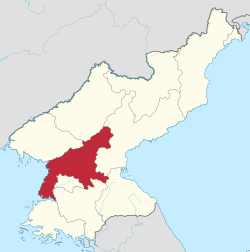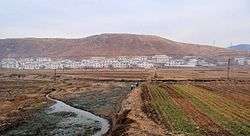South Pyongan Province
South Pyongan Province (Phyŏngannamdo; Korean pronunciation: [pʰjʌŋ.an.nam.do]) is a province of North Korea. The province was formed in 1896 from the southern half of the former Pyongan Province, remained a province of Korea until 1945, then became a province of North Korea. Its capital is Pyongsong.
South Pyongan Province 평안남도 | |
|---|---|
| Korean transcription(s) | |
| • Chŏsŏn'gŭl | 평안남도 |
| • Hancha | 平安南道 |
| • McCune‑Reischauer | P'yŏng'annam-do |
| • Revised Romanization | Pyeong-annam-do |
 | |
| Country | North Korea |
| Region | Kwanso |
| Capital | Pyongsong |
| Subdivisions | 5 cities; 19 counties |
| Government | |
| • Party Committee Chairman | Kim Tu-il[1] (WPK) |
| • People's Committee Chairman | Kang Hyong-bong[1] |
| Area | |
| • Total | 12,330 km2 (4,760 sq mi) |
| Population (2008) | |
| • Total | 4,051,696 |
| • Density | 330/km2 (850/sq mi) |
| Time zone | UTC+9 (Pyongyang Time) |
| Dialect | P'yŏngan |
Geography

The province is bordered by North Pyongan and Chagang Provinces to the north, South Hamgyong and Kangwon Provinces to the east and southeast and North Hwanghae Province and Pyongyang to the south. The Yellow Sea and Korea Bay are located to the west.
Administrative divisions
South P'yŏngan is divided into 1 special city (tŭkpyŏlsi); 5 cities (si); 16 counties (kun); and 3 districts (1 ku and 2 chigu).
Its administrative divisions are:
Cities
Counties
- Chungsan County (증산군/甑山郡)
- Hoechang County (회창군/檜倉郡)
- Maengsan County (맹산군/孟山郡)
- Mundok County (문덕군/文德郡)
- Nyongwon County (녕원군/寧遠郡)
- Onchon County (온천군/溫泉郡)
- Pukchang County (북창군/北倉郡)
- Pyongwon County (평원군/平原郡)
- Ryonggang County (룡강군/龍岡郡)
- Sinyang County (신양군/新陽郡)
- Songchon County (성천군/成川郡)
- Sukchon County (숙천군/肅川郡)
- Taehung County (대흥군/大興郡)
- Taedong County (대동군/大同郡)
- Unsan County (은산군/殷山郡)
- Yangdok County (양덕군/陽德郡)
Districts
The below former counties of South Pyongan were merged with Nampo in 2004 and are administered as part of that city:
- Chollima-guyok (천리마군/千里馬郡)
- Kangso-guyok (강서군/江西郡)
- Ryonggang County (룡강군/龍岡郡)
- Taean-guyok-gun (대안군/大安郡)
In 2010 the following county was merged with Nampo:[2]
- Onchon County (온천군/溫泉郡)
Gallery
- South Pyongan Provincial Office during Korea under Japanese rule's period.
See also
References
- 행정 구역 현황 (Haengjeong Guyeok Hyeonhwang;) (in Korean only)
- Administrative divisions of North Korea (in simplified Chinese; used as reference for Hanja)
- "Organizational Chart of North Korean Leadership" (PDF). Seoul: Political and Military Analysis Division, Intelligence and Analysis Bureau; Ministry of Unification. January 2018. Retrieved 17 October 2018.
- Kim So Yeol (February 15, 2011). "North Korea Splits No. 38 and 39 Departments Up Again". Daily NK. Retrieved November 15, 2012.
| Wikimedia Commons has media related to Pyongan-namdo. |